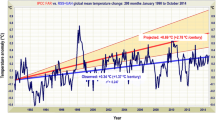Abstract
Despite great advances in understanding of the earth’s climate, our estimate of the global temperature rise due to a doubling of atmospheric CO2 has not greatly changed in a hundred years, and the estimate of the uncertainty on that number has actually increased. This is because while the basic mechanism of greenhouse-gas forcing of climate is well understood, the multiple, mostly positive, feedback loops that amplify this effect are not. The combined effect of many of these feedbacks can be seen in the record of past climate, and analysis of these suggests that our present models tend to under-predict the eventual, equilibrium climate change due to a given increase in atmospheric CO2. In the foreseeable future (next 20 years) climate modelling research will probably not materially decrease the uncertainty on predictions for the climate of 2100. The uncertainty will only start to decrease as we actually observe what happens to the climate. The best use of climate models at present is via ensembles of predictions that give a probabilistic description of the range of uncertainty involved in future climate. Recent studies suggest a skewed probability distribution, with a tail stretching out to high climate sensitivities. Combined with estimates of the likely economic impact of climate change, this strongly suggests that research should be concentrated on trying to reduce the uncertainty represented by this tail of low probability, but high impact, scenarios.
Similar content being viewed by others
References
Augustin L, Barbante C et al (2004) Eight glacial cycles from an Antarctic ice core. Nature 429(6992): 623–628
Houghton J (2001) Climate change 2001: the scientific basis. Cambridge University Press
Houghton JT, Jenkins GJ, Ephraums JJ (eds) (1990) Climate change: the IPCC scientific assessment. Campbridge University Press, Cambridge
Houghton JT, Meira Filho LG, Callendar BA, Harris N, Kattenberg A, Maskell K (eds) (1995) The science of climate chante: contributon pf working group 1 to the second assessment of the intergovernmental panel on climate change. Cambridge University Press, Cambridge
IPCC (2007) Climate change 2007: the physical science basis. Summary for policymakers
Nordhaus W, Boyer J (2003) Warming the world: economic models of global warming. MIT Press, Cambridge MA
Petit JR, Jouzel J et al (1999) Climate and atmospheric history of the past 420 000 years from the Vostok Ice Core, Antarctica. Nature 399: 429–436
Siegenthaler U, Stocker TF et al (2005) Stable carbon cycle–climate relationship during the late Pleistocene. Science 310(5752): 1313–1317
Stainforth DA, Aina T et al (2005) Uncertainty in predictions of the climate response to rising levels of greenhouse gases. Nature 433(7024): 403–406
Author information
Authors and Affiliations
Rights and permissions
About this article
Cite this article
Watson, A.J. Certainty and Uncertainty in Climate Change Predictions: What Use are Climate Models?. Environ Resource Econ 39, 37–44 (2008). https://doi.org/10.1007/s10640-007-9173-9
Accepted:
Published:
Issue Date:
DOI: https://doi.org/10.1007/s10640-007-9173-9




